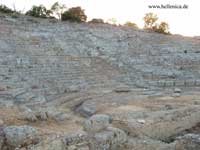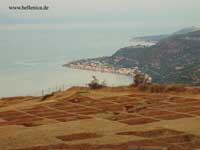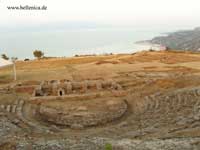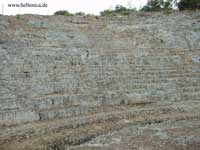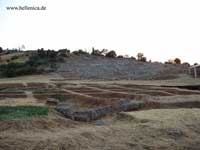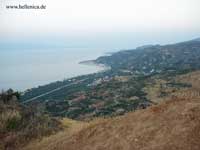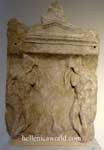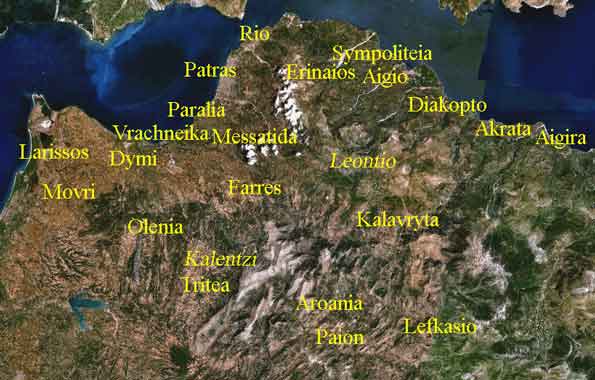.


Administrative Region : West Greece
Regional unit : Achaia
Aigeira or Aegira (Greek: Αιγείρα) is a former municipality in Achaea, West Greece, Greece. Since the 2011 local government reform it is part of the municipality Aigialeia, of which it is a municipal unit.[1] It is located about 500 m SW of the Gulf of Corinth in the northeastern part of Achaea. It is located on GR-8 and has an interchange connecting the new highway with GR-8A and E65. Distance from Patras is 67 km E, about 4 km NE of Akrata and 148 km W of Athens.
Subdivisions
The municipal unit Aigeira is subdivided into the following communities:
Aigeira
Aiges
Ampelokipoi
Chrysanthio
Exochi
Monastiri
Oasi
Perithori
Seliana
Sinevro
Vella
Name
The name comes from the Ancient Greek word aiges for goats.
Historical population
Year Municipal district Municipality
1981 1,320 -
1991 1,696 4,211
2001 - 4,503
Transportation
It has a train station with no building connecting the railway line with Patras - Aigio - Aigira - Derveni - Xylokastro - Kiato - Corinth.
Geography
Mountains are founded to the south. Forests are founded to the west and east. One of the hills in the south is named Palaiokastro.
History
Theatre in Aigeira.
The area was founded in the 3rd millennium BC. The city was known as Hyperesia (Greek: Υπερησία, Hyperesia) during Homeric times. In 688 BC, Hyperesia changed to Aegira.
According to Pausanias, Hyperesia was threatened once by a hostile army from Sicyon. The locals defended their city by placing burning torches on their goats' (aiges in Greek) antlers. As a result, the invadors left in fear while the Hyperesians renamed their town Αigeira (Greek: Aίγειρα) to honor the goats.
The city was prosperous and was one of the twelve most important cities in the Achaean League. It was also a member of the Achaean league. According to Pausanias, there was a statue of Zeus and Athena as well as a temple of Artemis Agrotera.
The city was destroyed when Achaea became part of the Roman Empire. Allegedly it was destroyed by a flood. Since then, the city is 400 m above sea level. Others said it was destroyed by an earthquake.
Archaeology
The Austrian Archaeological Institute made excavations in Aigeira in 1916. The team along with Otto Walter found the head of the statue of Zeus which according to Pausanias was a work by the Attic sculptor Eukleides Euclid. Walter also found the left arm, the finger at the right hand later.
From 1972, excavations led by Wilhelm Alzinger excavated the Mycenaean acropolis, the ancient theatre and several naiskoi next to the theatre (naiskos (small temple)). The floor of one of is decorated with a pebble mosaic representing an eagle with a serpent. Also, the Tycheio (sanctaury of Tyche) described by Pausanias was uncovered next to the theatre. Further to the north, foundations of two small temples were explored by Anton Bammer. On the terrace north of the acropolis, a presumably public building with banqueting rooms and bathing facilities was located ande excavated by Georg Ladstätter.
Sport
The town is home to the Aigeira Municipal Stadium.
Other
Its major soccer team is Thyella Aigeira, its uniform is black and white. Aigeira is also home to non-league amateur football club Panegiratikos.
See also
Communities of Achaia
References
^ Kallikratis law Greece Ministry of Interior (Greek)
Greece :
A - B - C - D - E - F - G - H - I - J - K - L - M -
N - O - P - Q - R - S - T - U - V - W - X - Y - Z
| Ancient Greece
Science, Technology , Medicine , Warfare, , Biographies , Life , Cities/Places/Maps , Arts , Literature , Philosophy ,Olympics, Mythology , History , Images Medieval Greece / Byzantine Empire Science, Technology, Arts, , Warfare , Literature, Biographies, Icons, History Modern Greece Cities, Islands, Regions, Fauna/Flora ,Biographies , History , Warfare, Science/Technology, Literature, Music , Arts , Film/Actors , Sport , Fashion --- |
From Wikipedia, All text is available under the terms of the GNU Free Documentation License


